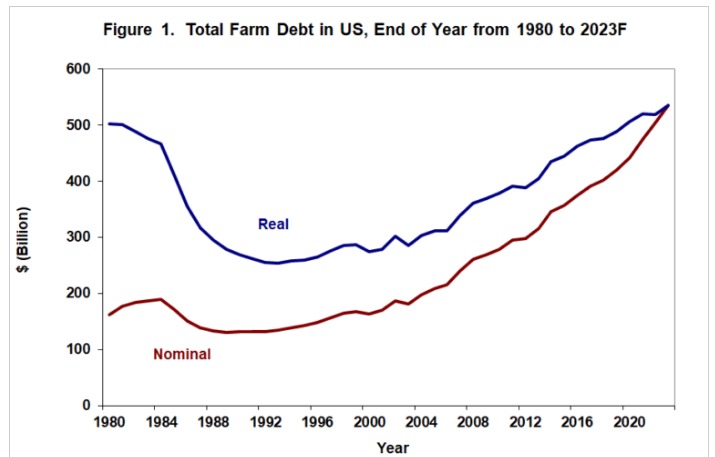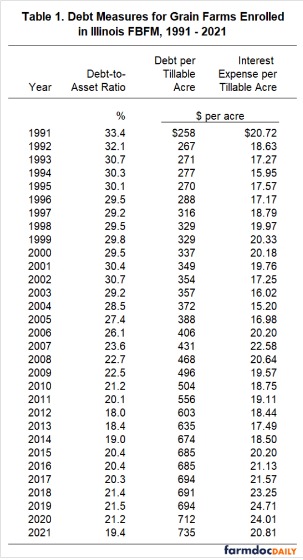By Bradley Zwilling
Illinois FBFM Association and Department of Agricultural and Consumer Economics
University of Illinois
Agricultural debt on a nominal basis in Illinois has been increasing since 1991. Data from the U.S. Department of Agriculture (USDA) and Illinois Farm Business Farm Management (FBFM) are shown to see if increasing debt levels pose problems for the financial health of Illinois farms. With more variability in the farm economy and rising inflation, increasing debt levels need to be monitored closely.
Overall Agricultural Debt Levels
USDA publishes estimates of total agricultural debt outstanding in the United States (see Economic Reporting Service, USDA website). This series is available from 1960 onwards and gives the amount of agricultural debt outstanding as of the year-end.
Nominally, agricultural debt reached a peak in 1984 of $188.8 billion (see the nominal line in Figure 1). From 1984 through 1989, agricultural producers retired debt and agricultural lenders wrote off some debt, resulting in a decline in total debt. By 1989, agricultural debt had declined by 31%, reaching a level of $131 billion.

Agricultural debt on a nominal basis in Illinois has been increasing since 1991. Data from the U.S. Department of Agriculture (USDA) and Illinois Farm Business Farm Management (FBFM) are shown to see if increasing debt levels pose problems for the financial health of Illinois farms. With more variability in the farm economy and rising inflation, increasing debt levels need to be monitored closely.
Overall Agricultural Debt Levels
USDA publishes estimates of total agricultural debt outstanding in the United States (see Economic Reporting Service, USDA website). This series is available from 1960 onwards and gives the amount of agricultural debt outstanding as of the year-end.
Nominally, agricultural debt reached a peak in 1984 of $188.8 billion (see the nominal line in Figure 1). From 1984 through 1989, agricultural producers retired debt and agricultural lenders wrote off some debt, resulting in a decline in total debt. By 1989, agricultural debt had declined by 31%, reaching a level of $131 billion.

Since 1990, agricultural debt increased an average of 4.4% per year. The rate of increase varied from year-to-year but exhibited no escalating or decreasing trends. The highest rate increases occurred between 2006-2007 and 2013-2014 when increases were 11.6% and 9.5%, respectively. Increases of less than 3% occurred nine times in this period while decreases happened in 3 years with the greatest at negative 3.2% in 2002-2003.
At the end of 2004, agricultural debt reached $197.6 billion, surpassing the previous high set in 1984. Increasing debt levels may cause concerns that financial stress occurring during the 1980s may repeat. However, the above debt levels are stated in nominal terms and do not take into consideration inflation’s devaluing impacts on the dollar.
Using the gross national product – implicit price deflator to state nominal debt levels in terms of 2023 dollars gives a different picture of debt levels (see the real line in Figure 1). In terms of 2023 dollars, agricultural debt started at $502 billion in 1980 before declining until before 1994. Since 1993, agricultural debt in real terms increased all but three years 2000, 2003, and 2012 (and forecasted decrease for 2022). Since 1990, the rate of increase averaged 2.2% for real debt levels, lower than the 4.4% nominal rate increase. The number forecasted for 2023 is the highest level in real terms ever with 2021’s value of $520 billion being the second highest.
Debt Levels on FBFM Grain Farms
Additional perspective on debt can be obtained by analyzing farm level data from FBFM. Table 1 presents average data for grain farms enrolled in FBFM who have certified-useable balance sheets. The data is stated in nominal terms, and debt levels are stated as of year-end 1991 through 2021. Three measures of debt level are presented in Table 1: debt-to-asset ratio, debt per tillable acre, and interest expense per tillable acre.
The debt-to-asset ratio had a very slight downward trend from 1993 to 2002. In 1993 and 2002, the debt-to-asset ratio was the same at 30.7%. From 2003 to 2012, the debt-to-asset ratio decreased at a faster pace, averaging 5.2%. In 2003 and 2012, the debt-to-asset ratios were 29.2% and 18.0%, respectively. Since 2012 until 2019, the debt-to-asset ratio has increased 2.6% annually. 2020 and 2021 have had negative increases, with 2021 ratio drop 9.8% from 2020. Since 1991, both asset and liability levels rose, with asset levels increasing slightly faster than debt levels.
Increases in debt can be seen by examining debt per tillable acre. Debt levels were $258 per tillable acre in 1991 compared to $357 in 2003, an increase of almost $100 per acre (see Table 1). Since 2003, debt levels per tillable acre increased more than $350 per acre. Between 1991 and 2003, debt per tillable acre increased an average of 2.7%, which is close to the 2.2% for all U.S. agricultural debt on a nominal basis. However since 2003, Illinois FBFM grain farms debt per tillable acre increased 4.3%, which is higher than the national average on a nominal basis. In 2020 and 2021, we saw increases of 3.% and 5.9% respectively, with the 2021 value being the highest since 2012.
While debt levels have increased, interest expense per tillable acre declined from 1999 to 2013, except for 2005, 2006, and 2007 which saw double-digit increases of 11.7%, 18.9% and 11.8%, respectively as well as 2.0% in 2011. Interest per tillable acre has been increasing since 2013 until a decrease in 2020 of 2.8%. The largest decrease in interest paid per tillable acre during this period was in 2021 with 13.3%. Interest expense was $20.72 per tillable acre in 1991 and $18.63 in 1992, while in 2020 and 2021 interest expense per tillable acres was $24.01 and $20.81, respectively. Lower interest rates in the late 90s and early 2000s caused the reduction in interest expense per tillable acre in the face of rising debt levels per acre. However, an interest rate increase in the mid-2000s caused an increase in interest expense per tillable acre during that period. From the mid-2000s until 2013, interest rates have decreased, but the amount of debt was increasing more rapidly. Interest rates have been historically low but increasing debt levels from 2013 to 2019 have led to interest expenses per tillable acre to increase on average 6.0% per year.
Summary
The importance a farmer puts on monitoring their debt level continues to be increasingly important in this period of high inflation. With higher inputs and variability, we will continue to see the increase in debt per acre. With interest rates moving higher, this means rising interest expense as well. A one percent increase in the average interest rate on all farm debt would lead to a 35% increase in interest expense per acres based on 2021 numbers. Finally, as debt levels increase, farmers need to monitor their term debt ratio. The greater the number, the greater the margin to meet all term debt payments. A ratio of one means that income available is equal to the term debt payments. Establishing or maintaining good recordkeeping during these times will help farmers identify areas of concern faster and be able to make better farm financial decisions.
Source : illinois.edu